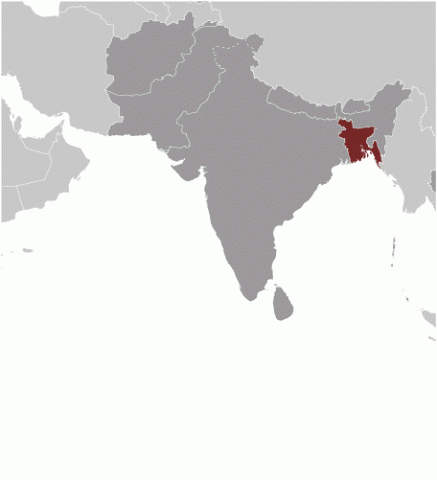Child Labor and Forced Labor Reports
Bangladesh


Minimal Advancement – Efforts Made but Continued Law and Practice that Delayed Advancement
In 2024, Bangladesh made minimal advancement in efforts to eliminate the worst forms of child labor. The government implemented nationwide programs to improve access to primary education for all children, including by providing pre-primary education in 3,214 government schools and providing training to 98,046 teachers. However, Bangladesh is assessed as having made only minimal advancement because the Department of Inspections for Factories and Establishments is not permitted to conduct unannounced inspections in the Export Processing Zones. Under the Export Processing Zone Labor Rules, the Department of Inspections for Factories and Establishments is required to indirectly provide notice to the Bangladesh Export Processing Zone Authority, which may result in employers being notified of inspections in advance. The lack of routine unannounced inspections may leave potential violations of child labor laws and other labor abuses undetected in the Export Processing Zones. Moreover, the Bangladesh Labor Act does not apply to children working in all sectors in which child labor occurs. Penalties for child labor violations can only be imposed after a lengthy legal process, and when courts do impose them, the fines are too low to deter child labor law violations. The government also did not publicly release information on its criminal law enforcement efforts related to child labor in 2024.
| Children | Age | Percent and Population |
|---|---|---|
| Working | 5 to 14 | 8.5% (2,739,992) |
| Hazardous Work by Children | 7 to 17 | 6.6% (524,749) |
| Attending School | 5 to 14 | 88.4% |
| Combining Work and School | 7 to 14 | 7.7% |
| Sector/Industry | Activity |
|---|---|
| Agriculture | Harvesting and processing crops, including salt.† Raising poultry. Fishing, including drying and processing fish,† including shrimp.† |
| Industry | Producing textiles, including jute, and garments, including tailoring and working in the informal garment sector.† Producing leather† and leather goods,† including footwear. Manufacturing bricks,† glass,† hand-rolled cigarettes (bidis),† matches,† plastic,† soap,† and furniture (steel).† Shipbreaking,† battery recycling,† construction,† and breaking bricks† and stones.† |
| Services | Domestic work. Garbage collecting, sorting, and recycling.† Working in transportation, including ticket taking,† welding,† blacksmithing, pulling rickshaws, driving, working as crew members on fishing boats, and repairing automobiles.† Working in retail shops, including grocery stores, bakeries, restaurants, weaving, and tailoring shops. |
| Categorical Worst Forms of Child Labor‡ | Use in illicit activities, including smuggling, robbery, and selling drugs. Forced begging and forced labor in the drying of fish, and the production of garments and bidis (hand-rolled cigarettes). Commercial sexual exploitation, sometimes as a result of human trafficking. Forced domestic work. |
† Determined by national law or regulation as hazardous and, as such, relevant to Article 3(d) of ILO C. 182.
‡ Child labor understood as the worst forms of child labor per se under Article 3(a)–(c) of ILO C. 182.
Children at Higher Risk
Most child laborers in Bangladesh work in the informal sector. Children living in coastal areas are likely to engage in child labor in the fishing sector, including drying and selling fish. Children from the minority Bihari community are forced into work at a young age, often in jobs considered less desirable. Children experiencing homelessness are forced to beg, pickpocket, and sell drugs. In border areas and the capital city, Dhaka, traffickers force children to produce and transport drugs. Children displaced by natural disasters are also at a higher risk for human trafficking and forced commercial sexual exploitation. Finally, there are reports of Bangladeshi officials taking bribes to provide human traffickers access to refugee camps and facilitate the trafficking of Rohingya children. NGOs allege that some officials allow traffickers to operate at the India-Bangladesh border and checkpoints.
Barriers to Education Access
More than 40 percent of schools lack basic sanitation facilities and hygiene services, and 1 in 5 schools lacks safe drinking water. Many schools in Bangladesh are overcrowded, and over 80 percent run double shifts of students. The country does not have an adequate number of teachers for an education system of its size. The Primary Teacher Training Institutes cannot keep up with the demand for teachers, particularly in rural areas. Other barriers to education include the high costs for transportation, uniforms, and school supplies. The Urdu-speaking Bihari minority children face education barriers due to having temporary addresses associated with residing in long-term camps. The Dalit and lower-caste Hindu children have lagged behind other groups in accessing education. According to reports, 60 percent of children with disabilities from ages 5 to 17 are not enrolled in formal education. Additionally, children born to mothers who are engaged in commercial sex work face barriers in accessing education since they are not permitted to obtain legal birth certificates. Many children from this community do not know their father’s name, which is a legal requirement to gain national identity cards or birth certificates needed for school enrollment. The Myanmar Curriculum, which provides Rohingya students with formal, standardized education based on Burma’s national education system, extended to Grade 11 for the 2024–2025 school year. However, the Myanmar education system as a whole faces implementation challenges such as a large Rohingya population, inexperienced teachers, inadequate teacher recruitment and retention, high turnover of host community teachers, and language and subject knowledge gaps.
| Standard | Age | Meets International Standards | Legislation |
|---|---|---|---|
| Minimum Age for Work | 14 | ✗ | Sections 1, 2, 34, and 284 of the Bangladesh Labor Act; Sections 159, 161, and 175 of the Bangladesh Export Processing Zone Labor Act, 2019 |
| Minimum Age for Hazardous Work | 18 | ✓ | Sections 39–42 of the Bangladesh Labor Act |
| Identification of Hazardous Occupations or Activities Prohibited for Children | ✓ | Sections 39–42 of the Bangladesh Labor Act; Statutory Regulatory Order Number 65, List of Worst Forms of Work for Children | |
| Prohibition of Slavery, Debt Bondage, and Forced Labor | ✓ | Sections 370, 371, and 374 of the Penal Code; Sections 2, 3, 6, and 9 of the Prevention and Suppression of Human Trafficking Act | |
| Prohibition of Child Trafficking | ✓ | Sections 2, 3, and 6 of the Prevention and Suppression of Human Trafficking Act; Sections 2 and 6 of the Suppression of Violence Against Women and Children Act | |
| Prohibition of Commercial Sexual Exploitation of Children | ✗ | Sections 372 and 373 of the Penal Code; Sections 78 and 80 of the Children’s Act; Sections 2, 3, 6, and 11 of the Prevention and Suppression of Human Trafficking Act; Sections 2 and 8 of the Pornography Control Act | |
| Prohibition of Using Children in Illicit Activities | ✗ | Section 79 of the Children’s Act | |
| Minimum Age for Voluntary State Military Recruitment | ✗ | Article 7 of the Army Act | |
| Prohibition of Compulsory Recruitment of Children by (State) Military | N/A* | ||
| Prohibition of Military Recruitment by Non-state Armed Groups | ✗ | Article 79 of the Children’s Act; Anti-Terrorism Act of 2009 | |
| Compulsory Education Age | ✗ | Sections 2 and 3 of the Primary Education (Compulsory) Act | |
| Free Public Education | ✓ | Article 17 of the Constitution |
* Country has no conscription
Although the Bangladesh government maintains a list of hazardous work prohibited for children, the list does not cover domestic work, a sector in which children are known to work long hours and are exposed to violence and sexual assault. Additionally, the Bangladesh Labor Act does not meet international standards for minimum age for work because a number of sectors and occupations are excluded from its application, including sailors, ocean-going vessels, agriculture farms with fewer than 10 workers, and domestic work. Bangladesh does not sufficiently criminalize commercial sexual exploitation of children because it only criminalizes prostitution when unless the child is under guardianship or a third party has involved them in commercial sex. Bangladesh criminalizes the use of children in the transport of drugs but not in their production. The government’s Primary Education Act stipulates a separate compulsory education age of 10, but this law is not binding as it has not been published in the national gazette. Even if the law were in effect, children between the ages of 10 and 14 would remain vulnerable to child labor as they are not required to attend school and are not able to legally work without restriction. The law permits conscription under certain circumstances and does not prohibit children under 18 from being conscripted. Further, there is no published law establishing 18, or 16 with safeguards for voluntariness, as the minimum age for voluntary recruitment by the state military.
| Organization/Agency | Role & Activities |
|---|
| Department of Inspection for Factories and Establishments (DIFE): Located within the Ministry of Labor and Employment (MOLE). Enforces labor laws, including those related to child labor and hazardous work. During the reporting period, DIFE organized refresher trainings for labor inspectors as part of its Annual Performance Agreement and National Integrity Strategy. Additionally, the department provided training for 35 inspectors on child labor. |
| Bangladesh Police: Enforce Penal Code provisions by protecting children from forced labor and commercial sexual exploitation. Through their Trafficking in Persons Monitoring Cell, the Bangladesh Police investigate cases of human trafficking and enforce the Prevention and Suppression of Human Trafficking Act’s anti-trafficking provisions. Operate victim support centers for trafficked women and children through partnership with 11 NGOs. |
| Overview of Enforcement Efforts | 2024 |
|---|---|
| Has a Labor Inspectorate | Yes |
| Able to Assess Civil Penalties | Yes |
| Routinely Conducted Worksite Inspections | Yes |
| Unannounced Inspections Permitted | No |
| Has a Complaint Mechanism | Yes |
| Imposed Penalties for Child Labor Violations | Yes |
| Conducted Criminal Investigations for Worst Forms of Child Labor Crimes | Unknown |
| Imposed Penalties for Worst Forms of Child Labor Crimes | Unknown |
In 2024, 442 labor inspectors conducted 34,008 worksite inspections, finding 3,697 child labor violations. It is unknown whether investigations into suspected cases of the worst forms of child labor were conducted, prosecutions were initiated, or perpetrators were convicted.
The Bangladesh Export Processing Zone Authority (BEPZA) is the official body of the government to promote, attract, and facilitate foreign investment in the Export Processing Zones, and is also responsible for ensuring business compliance with social, environmental, safety, and security regulations in these zones. Although DIFE has the authority to conduct inspections in the Export Processing Zones, it is required to notify BEPZA’s chairman in advance. Since some employers receive notification ahead of labor inspections, child labor violations may go undetected in the Export Processing Zones.
| Coordinating Body | Role & Activities |
|---|
| National Child Labor Welfare Council (NCLWC): Coordinates government efforts to guide and monitor the implementation of the National Plan of Action on the Elimination of Child Labor. Chaired by MOLE, comprises officials representing relevant government ministries, international organizations, child advocacy groups, and employer and worker organizations. During the reporting period, NCLWC organized 11 meetings. |
| Policy | Description & Activities |
|---|
| National Plan of Action on the Elimination of Child Labor (2021–2025): Identifies strategies for developing institutional capacity, increasing access to education and health services, raising social awareness, strengthening law enforcement, and creating prevention and reintegration programs. In 2024, MOLE monitored activities of the divisional councils and district- and sub-district-level coordination committees to ensure coordinated work to eliminate child labor. MOLE also organized divisional workshops and allocated resources to DIFE to organize activities to eliminate child labor. DIFE extended the implementation of the policy until December 2025, including a 2-year plan to eliminate child labor in the informal tailoring sector. |
| National Plan of Action for Prevention and Suppression of Human Trafficking (2018–2025): Establishes a plan to build government capacity to address human trafficking and provide economic and social safety nets for victims and vulnerable populations, particularly children. Led by the Ministry of Home Affairs. During the reporting period, the government continued to focus anti-trafficking funding on prevention efforts, partnership and transnational legal assistance, and monitoring and evaluation. |
† The government had other policies that may have addressed child labor issues or had an impact on child labor.
| Program | Description & Activities |
|---|
| Elimination of Hazardous Child Labor–Phase IV (2021–2023):‡ $33 million, 3-year project implemented by MOLE. Removed 90,000 children from hazardous labor in Phases I through III by providing informal and technical education, stipends, and awareness raising for employers and families. MOLE signed agreements with 112 selected NGOs to remove 100,000 children from hazardous work in Phase IV. In 2024, the project supported non-formal education and rehabilitation of working children. However, the project was insufficient to cover all geographical locations and all sectors involved in child labor, and irregularities in project implementation and identification of vulnerable children were found. |
| School Programs:‡ Second Chance Education is funded by the Bangladesh Rural Advancement Committee and provides informal schooling for children ages 8 to 14 who have dropped out of formal schools. In 2024, with the support of various NGOs, the government implemented nationwide programs to improve access to primary education for all children. The Ministry of Primary and Mass Education introduced a pilot providing pre-primary education in 3,214 government schools. It also trained 98,046 teachers on the Special Education Needs and Disability Framework in primary schools. |
| Child Protection Programs:‡ Child protection programs in Bangladesh include Child Sensitive Social Protection in Bangladesh (CSPB) II. The CSPB Project is implemented by the Ministry of Social Welfare’s Department of Social Services, with support from UNICEF, and aims to reduce the abuse and neglect of children, as well as violence against them. The project offers case management services to identify vulnerable children and provides psychological counseling through the Child Friendly Services hub and conditional cash support to reduce child labor. The government also operates a 24-hour emergency hotline called Child Helpline 1098. During the reporting period, the government added 1,200 social workers to the Department of Social Services, Child Protection. |
‡ Program is funded by the Government of Bangladesh.
† The government had other social programs that may have included the goal of eliminating or preventing child labor.
| Area | Suggested Action |
|---|---|
| Legal Framework | Extend minimum age for work protections to all children, including those engaged in domestic work and working on vessels and small farms. |
| Ensure that the types of hazardous work prohibited for children are comprehensive and include domestic work. | |
| Criminally prohibit the use, procuring, and offering of children for the production of drugs. | |
| Prohibit conscription of minors by state military. Ensure that the law establishes 18, or 16 with safeguards for voluntariness, as the minimum age for voluntary recruitment by the state military. | |
| Criminally prohibit the recruitment of children under age 18 by non-state armed groups. | |
| Criminally prohibit the use of a child for prostitution, regardless of how they came to be involved in prostitution. | |
| Ensure that laws establish a compulsory education age of at least 15 years. | |
| Enforcement | Empower labor inspectors to recommend or assess penalties for all labor violations, including those that are initial offenses, and increase the penalties for child labor violations to sufficiently deter future violations. |
| Conduct investigations and prosecutions of public officials who are complicit in the trafficking and commercial sexual exploitation of children, including those who accept bribes. | |
| Increase the number of labor inspectors from 442 to 1,861 to ensure adequate coverage of the labor force of approximately 74.5 million people. | |
| Permit and conduct unannounced labor inspections, including inspections for child labor, in Export Processing Zones. | |
| Prosecute all criminal child labor violations, as opposed to using mediation and settlement. | |
| Provide adequate training for inspectors and investigators on worst forms of child labor, including commercial sexual exploitation of children, to ensure that such cases are consistently investigated and prosecuted. | |
| Collect and publish national-level data on the enforcement of criminal laws relevant to child labor, including information on training for investigators and the number of investigations, prosecutions initiated, convictions attained, and penalties imposed. | |
| Investigate and hold accountable local government officials who hire children for government-funded job programs. | |
| Coordination | Establish a robust referral mechanism between civil and criminal enforcement agencies to promote coordination and cooperation to address child labor and its root causes. |
| Government Policies | Ensure that agencies responsible for implementation of the National Plan of Action on the Elimination of Child Labor are effectively coordinating their efforts and strategies. |
| Social Programs | Enhance efforts to make education accessible for all children by improving bathroom sanitation and resources, ensuring a well-developed distance-learning mechanism, increasing the number of schools, offsetting costs for transportation and school materials, and permitting all children to enroll in school regardless of whether they have a permanent address or the requisite identity documents. |
| Expand programs to address the scope of the child labor problem, including in the informal garment, leather, and fish-drying industries. |


















